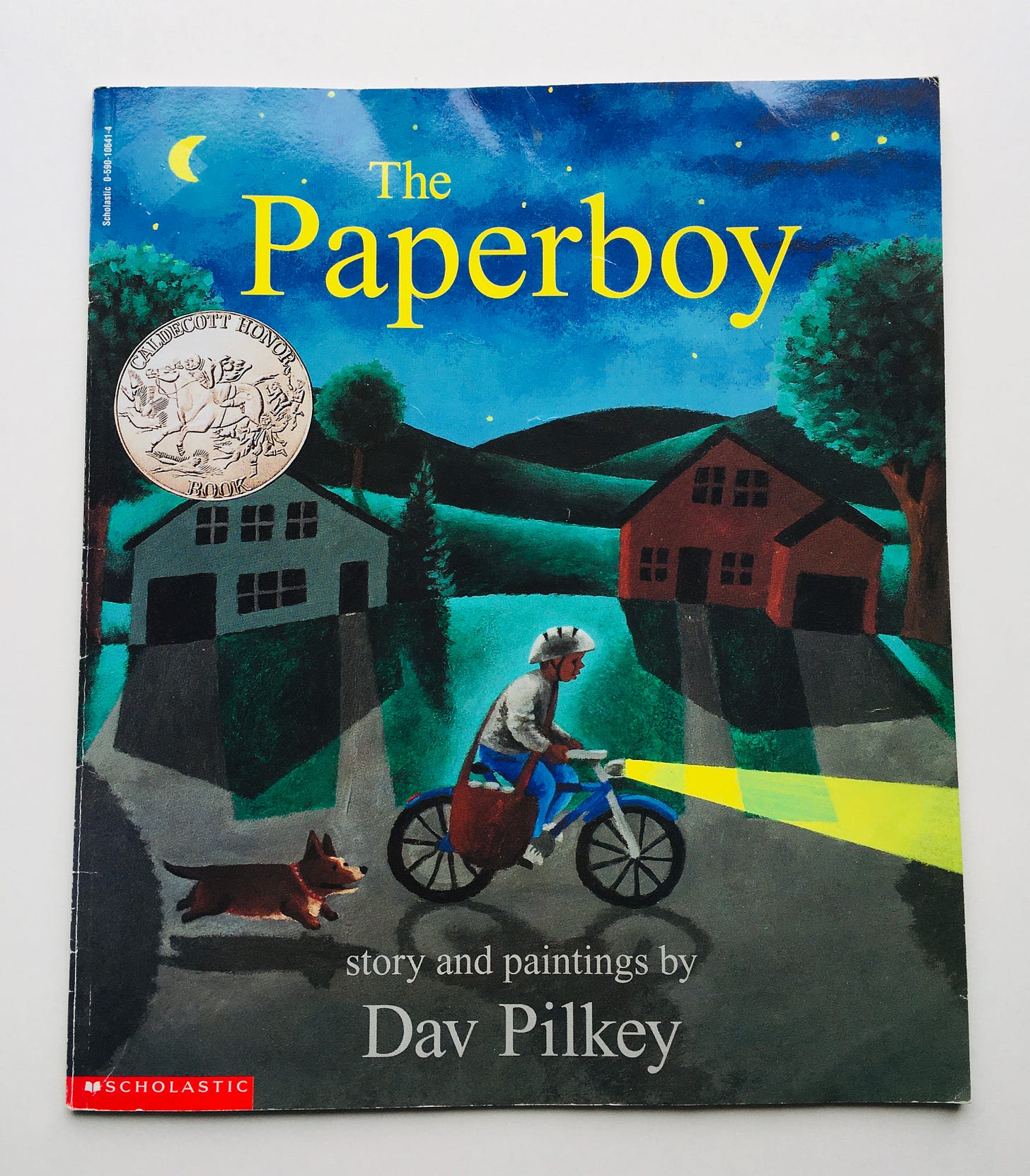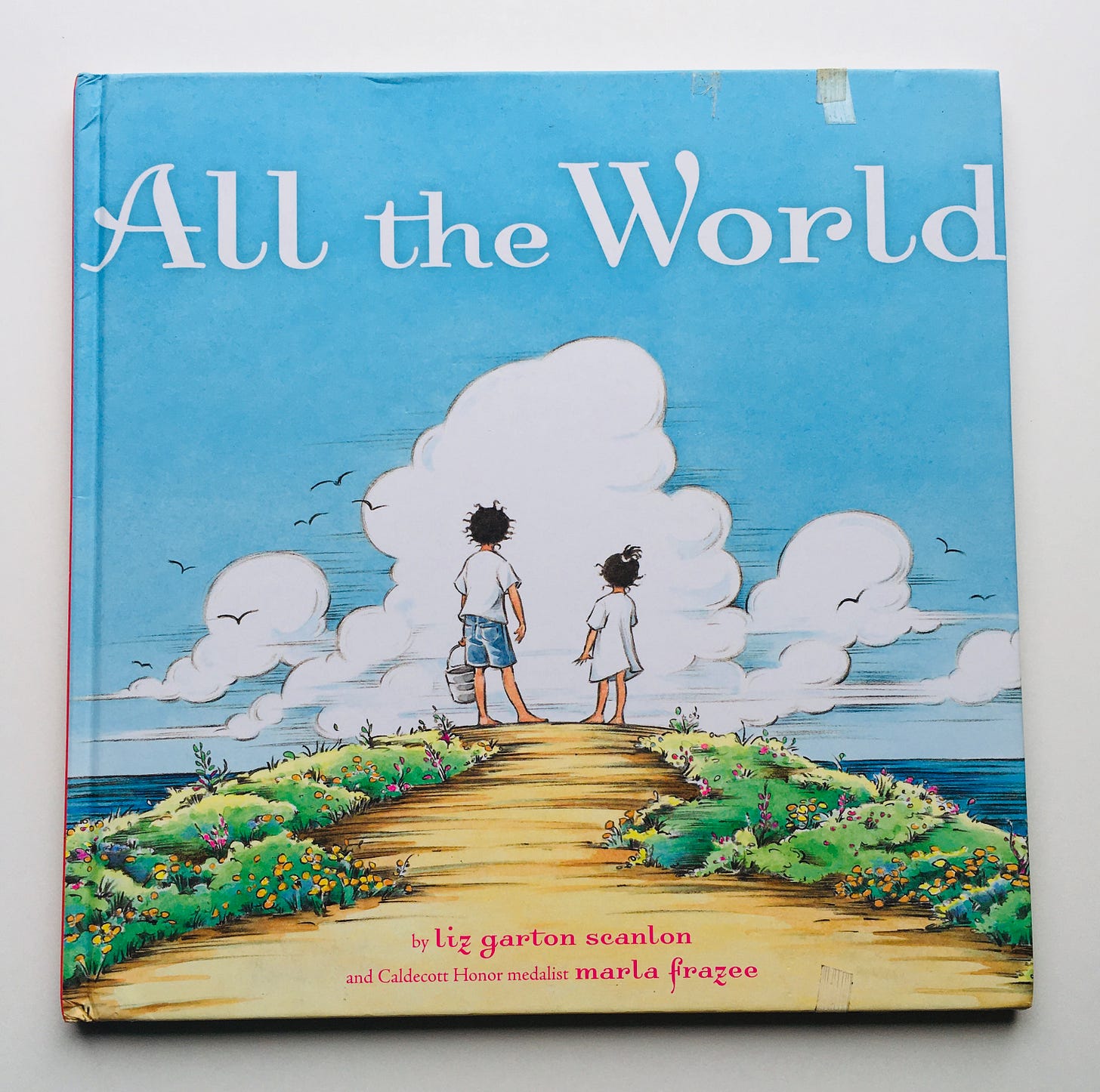Can we read? No. 11
Forgot to send this yesterday. Vacation is GOOD
The Paperboy by Dav Pilkey (1996)

If you have ever been awake before the sunrise, you know the time the paperboy and his faithful canine companion inhabit: “The mornings of the paperboy are still dark and they are always cold even in the summer. And on these cold mornings the paperboy’s bed is still warm and it’s always hard to get out — even for his dog… but they do.” From there the reader follows the two as they go through their routine, working hard but also working by heart, in a meditative manner that Pilkey’s muted illustrations match perfectly. There isn’t an enormous amount that happens here but this title offers a look into a very particular job — one that kids can actually do — and one that’s not only often unseen, but increasingly rare. When the paperboy returns home to his bed, which is still warm, there’s a great sense of serenity and closure, even as the day is opening for the rest of his family, and the world. It’s kind of a flip side to bedtime, “a time for dreaming,” and I like it because it gives the sense that even if we take an unconventional path, we can enter that quiet space, too.
In the Forest by Marie Hall Ets (1944)

For a long time I didn’t understand Marie Hall Ets* — her books seemed too old, too outdated, and frankly too uninteresting to me (I am looking at you, Play With Me) — and I couldn’t imagine my kids would ever sit down for a book in black and white. Enter In the Forest, as I insert my foot in my mouth. From the moment we first read this 76-year-old book, my kids adored it. It’s simply told and simply rendered — a little boy has a new horn and a paper hat and decides to go for a walk in the forest, where he meets up with all kinds of animals that make no sense together (on which continent, exactly, do a lion, a kangaroo, and a stork cohabitate?) and they do all kinds of things that make no sense in themselves (the bears count peanuts and eat jam, the monkeys demand a parade) — and yet it’s so perfectly entertaining in its absurd simplicity that it’s hard not to adore it. It is an old book and the illustrations reflect that and yet it remains captivating for anyone who believes it’s possible — or wishes it was possible — to come upon a place in the forest “made for picnics and games… and some ice cream and cake were there.” Yes, please.
*shoutout to a fellow Wisconsinite
Grandmother Spider Brings the Sun by Geri Keams, illustrated by James Bernardin (1995)

We love nature stories of every kind and have many authors and collections that we favor, but as with every part of our children’s library (and my own), I want to make sure we’re representing a variety of voices, cultures, perspectives, oral and written histories,. Indigenous storytelling (and outlooks) has a place on every bookshelf, and there are some excellent titles out there (see anything by Joseph Bruchac; we love Native American Animal Stories). Grandmother Spider Brings the Sun is one of them. A long time ago, one side of the world was always dark and Wolf was tired of everyone bumping into him all the time because of it. At first he wanted to go to the other side and ask for a piece of the sun, but Coyote, in his traditional trickster role, disagreed and convinced everyone they should steal the sun instead. Possum and Buzzard made valiant tries, but failed. Then Grandmother Spider volunteered. Readers aren’t privy to every detail here — Bernardin’s illustrations are fun to look at but leave enough to the imagination that the reader does more work in the head and heart than through the eyes (this is a compliment) — and I like how the focus is on oft-maligned creatures as well as on under-appreciated roles (when Wolf tells Grandma Spider she is too old and slow to do this job, she retorts, ‘I know I’m old. You don’t have to tell me I’m old. But I want to help my people one more time.’) Grandmother Spider succeeds slowly but with wisdom and tenacity. It’s a lovely tale.
To Be a Kid by Maya Ajmera and John Ivanko (1999)

I realize that I don’t often cover nonfiction picture books, and I suppose it’s because I haven’t come across a ton that I like yet, but those that feature photos of real children around the world are a notable exception. No one does these types of books better than Ann Morris (I highly recommend Shoes, Shoes, Shoes; Hats, Hats, Hats; Loving; On the Go; and Tools for toddlers — they are excellent and offer truly global views into topics that are visually and contextually fascinating to that age group). But To Be a Kid is hihgly worthy of in this category, not only for its interesting and diverse photography but for the uplifting messaging it offers. It begins, “To be a kid means being carried by those who love you…” and it’s hard not to take this literally (looking at pictures of children strapped to backs and riding on shoulders) and figuratively (absorbing that positive and loving message for what it is). The whole book is like this, running the gamut of experiences common to children around the world, no matter where they are: from school and learning, to walking, listening to stories, having snacks, playing, running, making art, dancing. I think it’s important that kids know there are, at any given time, billions of other kids all over the earth goofing off, making friends, being loved and cared for by their families and communities — especially in an age where an overheard news story or adult conversation could make it seem otherwise. This title is a visual and verbal celebration of all the goodness of childhood. And it’s an affirmation that childhood is — still, absolutely — something worth celebrating.
All the World by Liz Garton Scanlon, illustrated by Marla Frazee (2009)

Marla Frazee is probably my favorite illustrator, dead or alive. It all started with Everywhere Babies, when my oldest was just born, and only got better from there (Mrs. Biddlebox; New Baby Train; Harriet, You’ll Drive Me Wild; The Seven Silly Eaters — all on my list to share at some point). She’s wildly, ridiculously talented, and like all good illustrators, her art takes each story to another level. All the World is short on a story — it’s less a narrative and more a poem, but it’s a beautiful and calming one that emphasizes, more than anything, our togetherness, our commonalities, and who doesn’t need that these days? “Slip, trip, stumble, fall / Tip the bucket, spill it all / Better luck another day / All the world goes round this way.” This is well-written prose with a moving premise that I think it both instructive and reassuring to children and adults alike. Really though, it’s this lovely world through Frazee’s eyes that make this title something special.
Thanks for being here. You’re the best.

